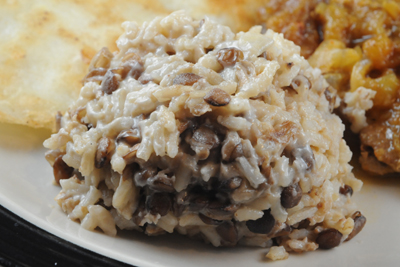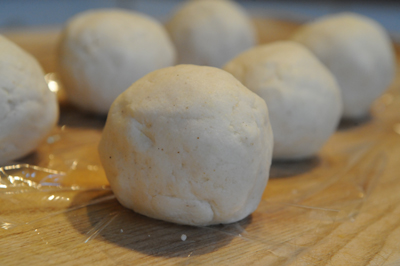Tomorrow I will be camping with 50 first graders. So I'm posting this entry one day early, because one day later is not going to happen. One day later I will be asleep. For the whole day.
Anyway, Hailey's first grade class is studying China, so she was really excited when I told her we were going to have homemade Chinese food. Of course, I already make loads of homemade Chinese food, so I'm not sure why this time should be any different for her. Granted, they are Americanized Chinese dishes, but my kids don't really know the difference.

This week's recipes come from Canton Province, also known as Guangdong Province, a 68,700 square mile region in Southern China. By land mass it is nowhere near the largest province in the country, yet it is the most populous with 79 million permanent residents and a population of 31 million migrants who live and work there at least six months out of the year. Among all other Chinese provinces Guandong ranks fourth in GDP per capita, which can be largely attributed to its low-value added manufacturing industry. As in cheap Chinese crap. And smart phones.
Yes, Guandong is the home of Foxconn City, which you may know as the point-of-origin for your beloved iPhone. You know, Foxconn City—a factory so large that it has its own fire brigade, grocery store, bank, bookstore, hospital, restaurants and television network, which I'm sure only broadcasts the most unbiased news and entertainment. It is also known for the 14 suicides and 4 attempted suicides that took place there between January and November of 2010, which it famously responded to by installing "suicide-prevention netting" and asking employees to sign no-suicide contracts.
Now, I've actually been sitting here for the last 10 minutes wondering how I can segue from Foxconn to Cantonese food. I don't think I can, so I'll just skip over that part.
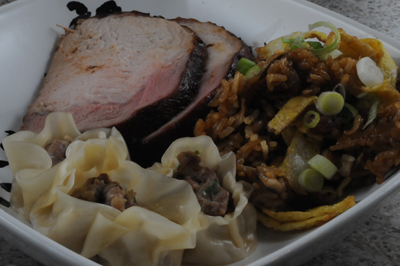
Cantonese food is what most Americans think of as Chinese food. It's what you order when you go to a Chinese restaurant. But for the most part, the stuff you get in a Chinese restaurant has been altered to suit American tastes and available ingredients. Which brings me to my next point: available ingredients.
Martin laughed when I told him I was having a hard time finding Cantonese recipes. Because he sees so much Cantonese food on Chinese menus, he figured that it would be pretty easy to find out how that food gets made. Well, yes, it actually
was easy to find Cantonese recipes, but nearly impossible to find Cantonese recipes that contained ingredients that were easy to find.
I did hit on my main course pretty quickly, but it was a pretty obvious choice:
Char Siu (Barbecued Pork)
- 1 pound pork belly, skin removed
- 2 tbsp rice wine
- 2 tbsp dark soy sauce
- 2 tbsp granulated sugar
- 2 cloves garlic, minced
- 1 1/2 tsp hoisin sauce
- 1/2 tsp Chinese five spice
- 2 tbsp honey
I picked this dish (which came from
Appetite for China) because it is one of the quintessential Cantonese dishes, and also because all of the ingredients were available at Safeway. At least that's what I thought until I looked a little closer at it, you know, one day before I was going to buy my groceries.
And for my next dish, which was adapted from
Christine's Recipes:
Stir Fried Glutinous Rice
- 2/3 cup glutinous rice
- 1 dried Chinese sausage (lap chong)
- 6 large dried shrimp
- 6 dried shiitakes
- 1 egg
- 2 tsp water
- chopped green onion
- 1 cup water
For the sauce:
- 1 tbsp light soy sauce
- 1/2 tsp dark soy sauce
- 1 tsp sugar
Now, if you've been reading this blog for any length of time, you just did a double-take when you read the words "dried shrimp." Or, if you're like me, you didn't notice them until you'd already gone to a lot of trouble finding and purchasing glutinous rice. More on that in a minute.
Finally, another side dish (since we always like to do Chinese food family-style):
Siu Maaih (Pork and Shrimp Dumpling)
- 2 small to medium shitake dried mushrooms
- 11 oz boneless pork, country-style rib, minced
- 6 oz shrimp, after shelling and deveining
- 1 small green onion, minced
- 1 tbsp soy sauce
- 2 tsp sugar
- 1/2 tsp salt
- dash white pepper
- 3 tbsp water
- 1 package round wonton wrappers
(This dim sum recipe came from
Traditional Chinese Recipes.)
So let's start with the pork, since it has to marinade for a couple of hours.
Now, when I first read this recipe I read "dark soy sauce" as "soy sauce." Because, you know, soy sauce is pretty dark. Later I learned that dark soy sauce is not in fact the full-sodium version of "lite soy sauce." The "lite" soy sauce we see in American grocery stores is just a bastardization of the real thing, and I don't think they really use it a whole lot in traditional Chinese cooking. Real "light" soy sauce is what we think of as plain old, full-sodium soy sauce. Dark soy sauce is actually soy sauce that has been thickened and sweetened.
Don't worry if you can't find it, though, you can approximate dark soy sauce by using one part regular soy sauce to one part molasses.
I was lucky enough to find some dark soy sauce locally, though. I know! If you live around here, you are rightfully amazed. At this point I have to give a little shout-out to the couple who run the Bonanza Gift Shop at 321A Broad Street in Nevada City. They have a tiny little 1/8th of a shelf devoted to Chinese groceries, and guess what I found there—dark soy sauce! And when I asked, they also went back to their freezer and produced a package of lap chong, which I needed for the glutinous rice. So that really made my morning, since I wasn't sure what I was going to do for a side dish at that point.
Anyway, the pork is blissfully easy and tastes like you spent all day making it. The very best kind of dish, in my opinion.
First, mix everything but the pork together in a large bowl. Then rub the marinade mixture all over the pork and place in the refrigerator for two or three hours.
Now, I didn't use a pork belly. I know it's more authentic, but my husband would have died of fat-exposure. So instead I just chose a pork loin.
Preheat your oven to 325 degrees. Take off some (but not all) of the marinade and then brush with honey. Roast until an internal thermometer reads 145 degrees, turning once and brushing honey on the other side. Remove from the oven and let rest for 5 to 10 minutes (Evidently, this is the new standard. I used to always cook my roast pork to 160, but now the USDA says 145 is fine as long as you allow the meat to rest for at least 3 minutes.). Slice and serve.
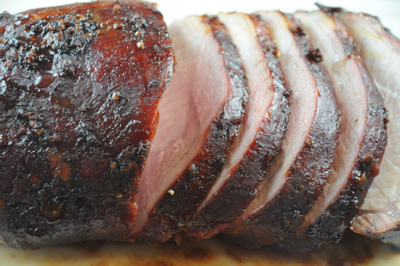
Next, the dim sum. These little dumplings were really fun to make. Here's how:
Soak the mushrooms for 30 minutes, then squeeze out the water and dice. Set aside.
Now separate out about 2/3 of the shrimp from the rest. Chop the 2/3, then put the remainder in a small food processor and puree.
Mix the pork, shrimp and mushrooms with everything else (except, obviously, the wonton wrappers). When well blended, pick up your first wonton wrapper. Dip a finger from the other hand into some water and use it to wet the edges of the wrapper.
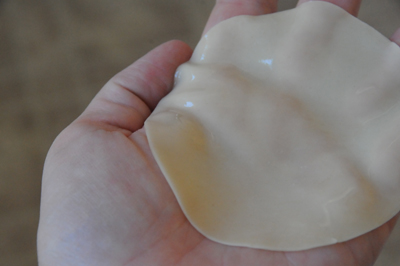
Then put a tablespoon or so of filling into the wrapper.
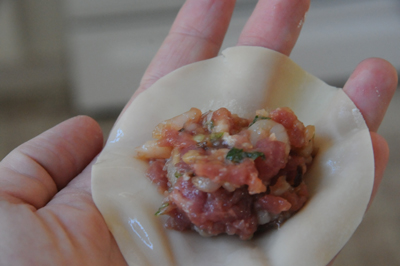
Now cup your hand to make a pretty flower shape. Or, if you're like me,
make something that looks like a wad of discarded paper that has been
left on the floor of my daughter's bedroom.
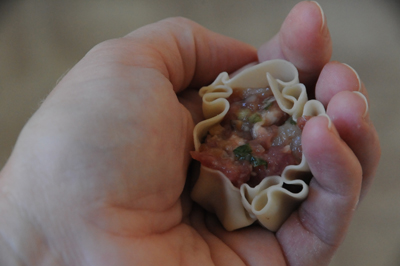
Repeat until you've used all
the filling.
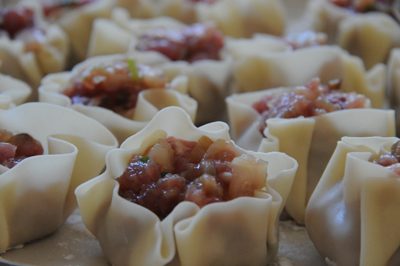
Steam the dumplings for approximately 7 minutes, or until a meat thermometer inserted in the center reads 145 degrees (160 if you're using pre-ground pork, because you can never be too careful). Hint: you don't need a bamboo steamer; you can use a regular electric vegetable steamer. Just make sure you line the steamer basket with wax paper, and don't let the dumplings touch each other because they will stick.
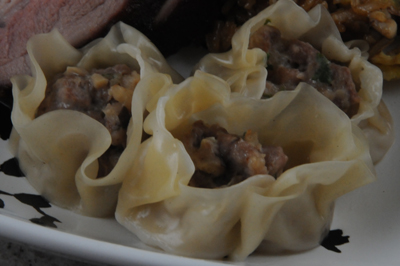
Now on to the glutinous rice. And the dried shrimp.
I went to a lot of trouble to get that glutinous rice, which is not the same as long grain rice. Also called "sticky" rice, glutinous rice becomes—you guessed it—sticky when cooked. So when I found this recipe I immediately went looking for some glutinous rice, without, of course, bothering to look at any of the other ingredients.
So the day before my grocery trip, I was making a shopping list when I saw it:
Dried shrimp.
It was too late to change my mind at that point, though I tried. I looked around for other versions of that recipe that might not contain dried shrimp, but it was sadly endemic. Then I just looked for other side dishes, but they all contained ingredients that you can't get in Grass Valley. Damn it.
So I decided to make this recipe anyway, and yes I vowed to be faithful and use the dried shrimp. Why? For one of four reasons:
a) I am dumb
b) I am a glutton for punishment
c) I am a glutton for punishing my husband
d) I am willing to give millions of people all over the world who enjoy foods made with dried shrimp the benefit of the doubt. Again.
I like to think it's d. So we'll just go with that.
Anyway, here's how you make the glutinous rice:
Soak the rice for at least 3 hours. You should also start soaking the dried shrimp at this point (I waited too long and mine weren't soft enough). For safety, hide the soaking shrimp in a drawer so your husband doesn't come home unexpectedly and see them.
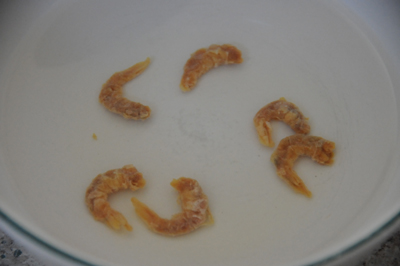 |
| Don't they look delicious?? |
(Note: the original version of this recipe also called for a dried scallop, which I omitted because there weren't any on that little shelf in Bonanza Gifts, but also because other versions of this recipe didn't call for one, so I figured it wasn't a traditional necessity).
Soak the mushrooms for at least 30 minutes, then squeeze out the water, chop up and set aside.
Remove the shrimp from the water, reserving about a cup (you can add a little water to make a cup if you need to). Cut the shrimp into a small dice and set aside.
Now crack the egg and beat with 2 tsp of water. Add a little salt. On a nonstick frying pan, heat some generic cooking oil and add the egg, swirling until it covers the whole bottom of the pan. Let it cook omelet-style until it is golden on one side, then flip it over. Laugh as it turns into a skewed and twisted lump.
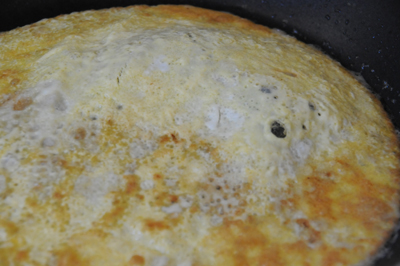 |
| Actually, I did manage to flip my egg over successfully, possibly for the first time in my life. |
Now fry it on the other side (if possible) until that side is also golden. Remove from heat and let cool, then cut into long strips (tip: using a pizza cutter will prevent tearing).
Dice the lap chong and put it in the frying pan.
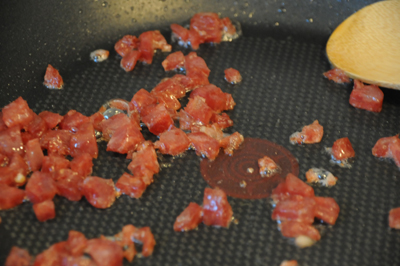
Like all sausage, lap chong is oily so wait until some of the oil comes out and then add the mushrooms and shrimp. Saute until everything is cooked through. Set that aside, too.
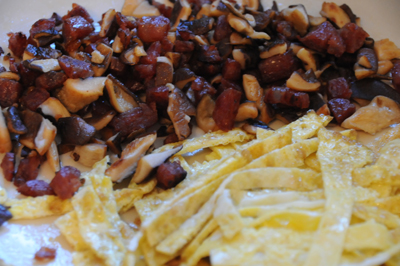
Rinse the glutinous rice and drain. Heat one or two tbsp of oil in your frying pan, then add the rice, stirring to coat.
Here's where this recipe starts to become kind of like a Chinese risotto. Add 2 tbsp of the shrimp water at a time to the rice, stirring until the water is absorbed. Then repeat until all the water has been used up. If the rice still isn't tender, you may need to add a few more tablespoons.
When the rice is cooked, add the sauce.
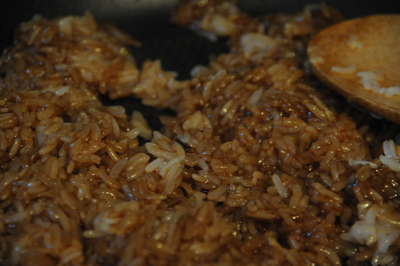
Return the lap chong, shrimp, mushrooms and egg to the pan and stir until mixed. Garnish with green onion.
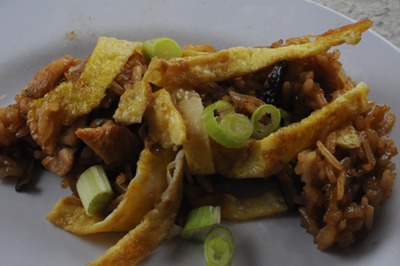
The verdict: shockingly, my kids all loved this meal. Especially the pork, which kept them coming back for seconds. Extra shockingly, the glutinous rice was good. I could taste the shrimp but it wasn't overpowering, not like the smell of it was that time I tried to dry it in my oven. In fact it tasted familiar, which makes me think that I probably
have actually had it in Chinese food before. So am I a convert? Nope. Because, ew.
My kids ate the dumplings, too, so it was really a home run as far as family meals go. And I told Hailey that she needed to make a full report back to her class the next day, which of course she forgot to do. Oh well.
Next week: Clipperton Island. Yes, that's right, a tiny deserted island with a poisonous lagoon where no one lives.
(Note: I skipped Christmas Island but will come back to it in a few weeks. I'm still in the middle of trying to track down a recipe source.)
For printable versions of this week's recipes:

















